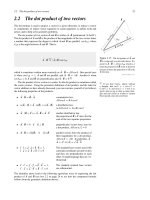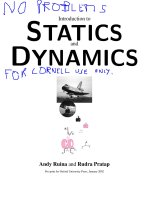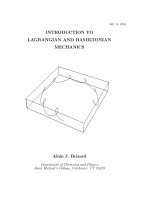- Trang chủ >>
- Khoa Học Tự Nhiên >>
- Vật lý
Introduction to thermodynamics and statistical mechanics
Bạn đang xem bản rút gọn của tài liệu. Xem và tải ngay bản đầy đủ của tài liệu tại đây (4.64 MB, 572 trang )
www.pdfgrip.com
This page intentionally left blank
www.pdfgrip.com
An Introduction to Thermodynamics and Statistical
Mechanics, Second Edition
This introductory textbook for standard undergraduate courses in
thermodynamics has been completely rewritten to explore a greater number of
topics more clearly and concisely. Starting with an overview of important
quantum behaviors, the book teaches students how to calculate probabilities in
order to provide a firm foundation for later chapters. It then introduces the ideas
of “classical thermodynamics” -- internal energy, interactions, entropy, and the
fundamental second law. These ideas are explored both in general and as they
are applied to more specific processes and interactions. The remainder of the
book deals with “statistical mechanics” -- the study of small systems interacting
with huge reservoirs.
The changes in this Second Edition have been made as a result of more than 10
years of classroom testing and feedback from students. To help students review
the important concepts and test their newly gained knowledge, each topic ends
with a boxed summary of ideas and results. Every chapter has numerous
homework problems, covering a broad range of difficulties. Answers are given
to odd-numbered problems, and solutions to even-numbered problems are
available to instructors at www.cambridge.org/9780521865579.
K S is a professor of physics at California Polytechnic State
University and has worked there for 32 years. He has spent time at the
University of Washington, Harvard, the University of North Carolina, and the
University of Michigan. As well as having written the First Edition of
Introduction to Thermodynamics and Statistical Mechanics, he has also written
books on ocean science.
www.pdfgrip.com
www.pdfgrip.com
An Introduction to
Thermodynamics and
Statistical Mechanics
Second Edition
Keith Stowe
California Polytechnic State University
www.pdfgrip.com
CAMBRIDGE UNIVERSITY PRESS
Cambridge, New York, Melbourne, Madrid, Cape Town, Singapore, São Paulo
Cambridge University Press
The Edinburgh Building, Cambridge CB2 8RU, UK
Published in the United States of America by Cambridge University Press, New York
www.cambridge.org
Information on this title: www.cambridge.org/9780521865579
© K. Stowe 2007
This publication is in copyright. Subject to statutory exception and to the provision of
relevant collective licensing agreements, no reproduction of any part may take place
without the written permission of Cambridge University Press.
First published in print format 2007
ISBN-13
ISBN-10
978-0-511-27406-0 eBook (EBL)
0-511-27406-8 eBook (EBL)
ISBN-13
ISBN-10
978-0-521-86557-9 hardback
0-521-86557-3 hardback
Cambridge University Press has no responsibility for the persistence or accuracy of urls
for external or third-party internet websites referred to in this publication, and does not
guarantee that any content on such websites is, or will remain, accurate or appropriate.
www.pdfgrip.com
Contents
Preface
List of constants, conversions, and prefixes
Part I Setting the scene
1 Introduction
page vii
xii
1
3
Part II Small systems
2 Statistics for small systems
3 Systems with many elements
23
25
40
Part III Energy and the first law
4 Internal energy
5 Interactions between systems
63
65
79
Part IV States and the second law
6 Internal energy and the number of accessible states
7 Entropy and the second law
8 Entropy and thermal interactions
99
101
117
135
Part V Constraints
9 Natural constraints
10 Models
11 Choice of variables
12 Special processes
13 Engines
14 Diffusive interactions
153
155
186
210
226
252
287
Part VI Classical statistics
15 Probabilities and microscopic behaviors
16 Kinetic theory and transport processes in gases
17 Magnetic properties of materials
18 The partition function
327
329
352
369
382
v
www.pdfgrip.com
vi
Contents
Part VII Quantum statistics
19 Introduction to quantum statistics
20 Quantum gases
21 Blackbody radiation
22 The thermal properties of solids
23 The electrical properties of materials
24 Low temperatures and degenerate systems
399
401
422
438
457
477
504
Appendices
Further reading
Problem solutions
Index
531
537
538
551
www.pdfgrip.com
Preface
Goals
The subject of thermodynamics was being developed on a postulatory basis long
before we understood the nature or behavior of the elementary constituents of
matter. As we became more familiar with these constituents, we were still slow to
place our trust in the “new” field of quantum mechanics, which was telling us that
their behaviors could be described correctly and accurately using probabilities
and statistics.
The influence of this historical sequence has lingered in our traditional thermodynamics curriculum. Until recently, we continued to teach an introductory
course using the more formal and abstract postulatory approach. Now, however,
there is a growing feeling that the statistical approach is more effective. It demonstrates the firm physical and statistical basis of thermodynamics by showing how
the properties of macroscopic systems are direct consequences of the behaviors
of their elementary constituents. An added advantage of this approach is that it is
easily extended to include some statistical mechanics in an introductory course.
It gives the student a broader spectrum of skills as well as a better understanding
of the physical bases.
This book is intended for use in the standard junior or senior undergraduate
course in thermodynamics, and it assumes no previous knowledge of the subject.
I try to introduce the subject as simply and succinctly as possible, with enough
applications to indicate the relevance of the results but not so many as might risk
losing the student in details. There are many advanced books of high quality that
can help the interested student probe more deeply into the subject and its more
specialized applications.
I try to tie everything straight to fundamental concepts, and I avoid “slick
tricks” and the “pyramiding” of results. I remain focused on the basic ideas and
physical causes, because I believe this will help students better understand, retain,
and apply the tools and results that we develop.
Active learning
I think that real learning must be an active process. It is important for the student
to apply new knowledge to specific problems as soon as possible. This should be a
vii
www.pdfgrip.com
viii
Preface
daily activity, and problems should be attempted while the knowledge is still fresh.
A routine of frequent, timely, and short problem-solving sessions is far superior
to a few infrequent problem-solving marathons. For this reason, at the end of each
chapter the text includes a very large number of suggested homework problems,
which are organized by section. Solutions to the odd-numbered problems are at
the end of the book for instant feedback.
Active learning can also be encouraged by streamlining the more passive
components. The sooner the student understands the text material, the sooner he
or she can apply it. For this reason, I have put the topics in what I believe to be the
most learning-efficient order, and I explain the concepts as simply and clearly as
possible. Summaries are frequent and are included within the chapters wherever
I think would be helpful to a first-time student wrestling with the concepts. They
are also shaded for easy identification. Hopefully, this streamlining of the passive
aspects might allow more time for active problem solving.
Changes in the second edition
The entire book has been rewritten. My primary objective for the second edition
has been to explore more topics, more thoroughly, more clearly, and with fewer
words. To accomplish this I have written more concisely, combined related topics,
and reduced repetition. The result is a modest reduction in text, in spite of the
broadened coverage of topics.
In addition I wanted to correct what I considered to be the two biggest problems
with the first edition: the large number of uncorrected typos and an incomplete
description of the chemical potential. A further objective was to increase the
number and quality of homework problems that are available for the instructor
or student to select from. These range in difficulty from warm-ups to challenges.
In this edition the number of homework problems has nearly doubled, averaging
around 40 per chapter. In addition, solutions (and occasional hints) to the oddnumbered problems are given at the back of the book. My experience with students
at this level has been that solutions give quick and efficient feedback, encouraging
those who are doing things correctly and helping to guide those who stumble.
The following list expands upon the more important new initiatives and features in this edition in order of their appearance, with the chapters and sections
indicated in parentheses.
r Fluctuations in observables, such as energy, temperature, volume, number of particles,
etc. (Sections 3A, 3C, 7C, 9B, 19A)
r Improved discussion and illustrations of the chemical potential (Sections 5C, 8A, 9E,
14A)
r The explicit dependence of the number of accessible states on the system’s internal
energy, volume, and number of particles (Chapter 6)
r Behaviors near absolute zero (Sections 9H, 24A, 24B)
www.pdfgrip.com
Preface
r
r
r
r
r
r
r
r
r
r
r
r
r
r
r
r
r
r
Entropy and the third law (Section 8D)
A new chapter on interdependence among thermodynamic variables (Chapter 11)
Thermal conduction, and the heat equation (Section 12E)
A more extensive treatment of engines, including performance analysis (Section 13F),
model cycles, a description of several of the more common internal combustion engines
(Section 13H), and vapor cycles (Section 13I)
A new chapter on diffusive interactions, including such topics as diffusive equilibrium,
osmosis, chemical equilibrium, and phase transitions (Chapter 14)
Properties of solutions (colligative properties, vapor pressure, osmosis, etc.)
(Section 14B)
Chemical equilibrium and reaction rates (Section 14C)
A more thorough treatment of phase transitions (Section 14D)
Binary mixtures, solubility gap, phase transitions in minerals and alloys, etc.
(Section 14E)
Conserved properties (Section 16E)
Calculating the chemical potential for quantum systems (Section 19E)
Chemical potential and internal energy for quantum gases (Section 20D)
Entropy and adiabatic processes in photon gases (Section 21E)
Thermal noise (Section 21F)
Electrical properties of materials, including band structure, conductors, intrinsic and
doped semiconductors, and p--n junctions (Chapter 23)
Update of recent advances in cooling methods (Section 24A)
Update of recent advances in Bose--Einstein condensation (Section 24B)
Stellar collapse (Section 24C)
Organization
The book has been organized to give the instructor as much flexibility as possible.
Some early chapters are essential for the understanding of later topics. Many
chapters, however, could be skipped at a first reading or their order rearranged as
the instructor sees fit. To help the instructor or student with these choices, I give
the following summary followed by more detailed information.
Summary of organization
Part I Introduction
Chapter 1 essential if the students have not yet had a course in quantum mechanics. Summarizes important quantum effects
Part II Small systems
Chapter 2 and Chapter 3 insightful, but not needed for succeeding chapters
www.pdfgrip.com
ix
x
Preface
Part III Energy and the first law
Chapter 4, Chapter 5 and Chapter 6 essential
Part IV States and the second law
Chapter 6, Chapter 7 and Chapter 8 essential
Part V Constraints
Chapter 9 essential
Chapter 10, Chapter 11, Chapter 12, Chapter 13 and Chapter 14
any can be skipped
Part VI Classical statistics
Chapter 15 essential
Chapter 16, Chapter 17 and Chapter 18
any order, and
any order, and any can be skipped
Part VII Quantum statistics
Chapter 19, Chapter 20 A, B essential
Chapter 21, Chapter 22, Chapter 23 and Chapter 24
skipped
any order, and any can be
More details
Part I -- Introduction Chapter 1 is included for the benefit of those students
who have not yet had a course in quantum mechanics. It summarizes important
quantum effects that are used in examples throughout the book.
Chapters 2 and 3 study systems with only a few elements. By studying small systems first the student develops both a better appreciation and also a better understanding of the powerful tools that we will need for
large systems in subsequent chapters. However, these two chapters are not essential for understanding the rest of the book and may be skipped if the instructor
wishes.
Part II -- Small systems
Part III -- Energy and the first law Chapters 4 and 5 are intended to give the
student an intuitive physical picture of what goes on within interacting systems on
a microscopic scale. Although the mathematical rigor comes later, this physical
understanding is essential to the rest of the book so these two chapters should not
be skipped.
Chapters 6, 7, and 8 are the most important in the book. They develop the statistical basis for much of thermodynamics.
Part IV -- States and the second law
Part V -- Constraints Chapter 9 derives the universal consequences of the fundamental ideas of the preceding three chapters. So this chapter shows why things
must behave as they do, and why our “common sense” is what it is. Chapters 10--14
www.pdfgrip.com
Preface
all describe the application of constraints to more specific systems. None of these
topics is essential, although some models in Chapter 10 would be helpful in understanding examples used later in the book; if Chapters 11 and 12 are covered, they
should be done in numerical order. Topics in these five chapters include equations
of state and models, the choice and manipulation of variables, isobaric, isothermal, and adiabatic processes, reversibility, important nonequilibrium processes,
engines, diffusion, solutions, chemical equilibrium, phase transitions, and binary
mixtures.
Part VI -- Classical statistics Chapter 15 develops the basis for both classical “Boltzmann” and quantum statistics. So even if you go straight to quantum
statistics, this chapter should be covered first. Chapters 16, 17, and 18 are applications of classical statistics, each of which has no impact on any other material
in the book. So they may be skipped or presented in any order with no effect on
subsequent material.
Chapter 19 introduces quantum statistics, and
the first two sections of Chapter 20 introduce quantum gases. These provide the
underpinnings for the subsequent chapters and therefore must be covered first.
The remaining four (Chapters 21--24 ) are each independent and may be skipped
or presented in any order, as the instructor chooses.
Part VII -- Quantum statistics
Acknowledgments
I wish to thank my students for their ideas, encouragement, and corrections,
and my colleagues Joe Boone and Rich Saenz for their careful scrutiny and
thoughtful suggestions. I also appreciate the suggestions received from Professors
Robert Dickerson and David Hafemeister (California Polytechnic State University), Albert Petschek (New Mexico Institute of Mining and Technology), Ralph
Baierlein (Wesleyan University), Dan Wilkins (University of Nebraska, Omaha),
Henry White (University of Missouri), and I apologize to the many whose names
I forgot to record.
www.pdfgrip.com
xi
List of constants, conversions, and prefixes
Constants
acceleration of gravity
Avogadro’s number
Boltzmann’s constant
Coulomb constant
elementary unit of charge
gas constant
gravitational constant
magnetons
Bohr magneton
nuclear magneton
masses
atomic mass unit
electron mass
neutron mass
proton mass
Planck’s constant
speed of light in vacuum
Stefan--Boltzmann constant
g = 9.807 m/s2
NA = 6.022 × 1023 particles/mole
k = 1.381 × 10−23 J/K = 8.617 × 10−5 eV/K
1/4π ε0 = 8.988 × 109 kg m3 /(s2 C2 )
e = 1.602 × 10−19 C
R = NA k = 8.315 J/(K mole)
= 0.08206 liter atm/(K mole)
G = 6.673 × 10−11 m3 /(kg s2 )
àB = 9.274 ì 1024 J/T = 5.788 ì 105 eV/T
àN = 5.051 ì 1027 J/T = 3.152 ì 108 eV/T
u = 1.661 × 10−27 kg
me = 9.109 × 10−31 kg
mn = 1.675 × 10−27 kg
mp = 1.673 × 10−27 kg
h = 6.626 × 10−34 J s = 4.136 × 10−15 eV s
h = h/2π = 1.055 × 10−34 J s = 6.582 × 10−16 eV s
c = 2.998 × 108 m/s
σ = 5.671 × 10−8 W/(m2 K4 )
Conversions
◦
1 A = 10−10 m
1 liter = 10−3 m3
1 atm = 1.013 × 105 Pa
log10 x = 0.4343 ln x
ex = 100.4343x
1 eV = 1.602 × 10−19 J
1 cal = 4.184 J = 0.04129 liter atm
1 T = 1 Wb/m2 = 104 G
temperature (K) = temperature (◦ C) + 273.15 K
xii
www.pdfgrip.com
List of constants, conversions, and prefixes
Prefixes
tera
giga
mega
kilo
centi
milli
micro
nano
pico
femto
T
G
M
k
c
m
µ
n
p
f
1012
109
106
103
10−2
10−3
10−6
10−9
10−12
10−15
www.pdfgrip.com
xiii
www.pdfgrip.com
Part I
Setting the scene
www.pdfgrip.com
www.pdfgrip.com
Chapter 1
Introduction
A The translation between microscopic and macroscopic behavior
A.1 The statistical tools
A.2 Thermodynamics
B Quantum effects
B.1 Electrical charge
B.2 Wave nature of particles
B.3 Uncertainty principle
B.4 Quantum states and phase space
B.5 Density of states
B.6 Angular momentum
B.7 Magnetic moments
B.8 Bound states
C Description of a state
3
3
4
5
5
6
7
9
10
11
14
15
17
Imagine you could shrink into the atomic world. On this small scale, motion is
violent and chaotic. Atoms shake and dance wildly, and each carries an electron
cloud that is a blur of motion. By contrast, the behavior of a very large number
of atoms, such as a baseball or planet, is quite sedate. Their positions, motions,
and properties change continuously yet predictably. How can the behavior of
macroscopic systems be so predictable if their microscopic constituents are so
unruly? Shouldn’t there be some connection between the two?
Indeed, the behaviors of the individual microscopic elements are reflected in
the properties of the system as a whole. In this course, we will learn how to make
the translation, either way, between microscopic behaviors and macroscopic
properties.
A The translation between microscopic and
macroscopic behavior
A.1 The statistical tools
If you guess whether a flipped coin will land heads or tails, you have a 50% chance
of being wrong. But for a very large number of flipped coins, you may safely
3
www.pdfgrip.com
4
Introduction to thermodynamics and statistical mechanics
(b)
(a)
Figure 1.1 (a) If you know the probabilities for one single coin flip then you can
predict the heads--tails distribution for a large number of them. Conversely, by
observing the heads--tails distribution for a large number of flipped coins, you can
infer the probabilities for any one of them. (b) What is the probability that a rolled
dice will land with six dots up? If a large number of dice were rolled, roughly what
fraction of them would land with six dots up?
assume that nearly half will land heads. Even though the individual elements are
unruly, the behavior of a large system is predictable (Figure 1.1).
Your prediction could go the other way, too. From the behavior of the entire
system, you might predict probabilities for the individual elements. For example,
if you find that one sixth of a large number of rolled dice show sixes (i.e., six
dots up), you can correctly infer that the probability for any one die to show
a six is 1/6 (Figure 1.1b). When a system is composed of a large number of
identical elements, you can use the observed behavior of an individual element
to predict the properties of the whole system, or conversely, you can use the
observed properties of the entire system to deduce the probable behaviors of the
individual elements.
The study of this two-way translation between the behavior of the individual elements and the properties of the system as a whole is called statistical
mechanics. One of the goals of this book is to give you the tools for making this
translation, in either direction, for whatever system you wish.
A.2 Thermodynamics
The industrial revolution and the attendant proliferation in the use of engines gave
a huge impetus to the study of thermodynamics, a name that obviously reflects
the early interest in turning heat into motion. The study now encompasses all
forms of work and energy and includes probing the relationships among system
parameters, such as how pressure influences temperature, how energy is converted
from one form to another, etc.
www.pdfgrip.com
Introduction
Considerable early progress was made with little or no knowledge of the
atomic nature of matter. Now that we understand matter’s elementary constituents
better, the tools of thermodynamics and statistical mechanics help us improve
our understanding of matter and macroscopic systems at a more fundamental
level.
Summary of Section A
If a system is composed of many identical elements, the probable behaviors of an
individual element may be used to predict the properties of the system as a whole or,
conversely, the properties of the system as a whole may be used to infer the probable
behaviors of an individual element. The study of the statistical techniques used to
make this two-way translation between the microscopic and macroscopic behaviors
of physical systems is called statistical mechanics. The study of interrelationships
among macroscopic properties is called thermodynamics. Using statistical tools, we
can relate the properties of a macroscopic system to the behaviors of its individual
elements, and in this way obtain a better understanding of both.
B Quantum effects
When a large number of coins are flipped, it is easy to predict that nearly half will
land heads up. With a little mathematical sophistication, you might even be able
to calculate typical fluctuations or probabilities for various possible outcomes.
You could do the same for a system of many rolled dice.
Like coins and dice, the microscopic constituents of physical systems also have
only certain discrete states available to them, and we can analyze their behaviors
with the same tools that we use for systems of coins or dice. We now describe a
few of these important “quantized” properties, because we will be using them as
examples in this course. You may wish to refer back to them when you arrive at
the appropriate point later in the book.
B.1 Electrical charge
For reasons we do not yet understand, nature has provided electrical charge in
fundamental units of 1.6 × 10−19 coulombs, a unit that we identify by e:
e = 1.602 × 10−19 C.
We sometimes use collisions to study the small-scale structure of subatomic
particles. No matter how powerful the collision or how many tiny fragments are
www.pdfgrip.com
5
6
Introduction to thermodynamics and statistical mechanics
produced, the charge of each is always found to be an integral number of units of
the fundamental charge, e.1
B.2 Wave nature of particles
In the nineteenth century it was thought that energy could go from one point to
another by either of two distinct processes: the transport of matter or the propagation of waves. Until the 1860s, we thought waves could only propagate through
matter. Then the work of James Clerk Maxwell (1831--79) demonstrated that
electromagnetic radiation was also a type of wave, with oscillations in electric
and magnetic fields rather than in matter. These waves traveled at extremely high
speeds and through empty space. Experiments with appropriate diffraction gratings showed that electromagnetic radiation displays the same diffractive behavior
as waves that travel in material media, such as sound or ocean waves.
Then in the early twentieth century, experiments began to blur the distinction
between the two forms of energy transport. The photoelectric effect and Compton
scattering demonstrated that electromagnetic “waves” could behave like “particles.” And other experiments showed that “particles” could behave like “waves:”
when directed onto appropriate diffraction gratings, beams of electrons or other
subatomic particles yielded diffraction patterns, just as waves do.
The wavelength λ for these particle--waves was found to be inversely proportional to the particle’s momentum p; it is governed by the same equation used for
electromagnetic waves in the photoelectric effect and Compton scattering,
λ=
h
p
(h = 6.626 × 10−34 J s).
(1.1)
Equivalently, we can write a particle’s momentum in terms of its wave number,
k = 2π/λ.
p=
h 2π
h
=
= hk
λ
2π λ
( h = h/2π = 1.055 × 10−34 J s).
(1.2)
The constant of proportionality, h, is Planck’s constant, and when divided by 2π
it is called “h-bar.”
We do not know why particles behave as waves any more than we know
why electrical charge comes in fundamental units e. But they do, and we can
set up differential “wave equations” to describe any system of particles we like.
The solutions to these equations are called “wave functions,” and they give us
the probabilities for various behaviors of the system. In the next few pages we
describe some of the important consequences.
1
For quarks the fundamental unit would be e/3. But they bind together to form the observed elementary particles (protons, neutrons, mesons, etc.) only in ways such that the total electrical charge
is in units of e.
www.pdfgrip.com
Introduction
7
Figure 1.2 The
superposition of the sine
waves below yields the
sawtooth wave above.
B.3 Uncertainty principle
Any function of the variable x on (−∞, ∞) can be written as a superposition
of sine wave components of various wavelengths (Figure 1.2). These sine wave
components may be either of the form sin kx and cos kx, or eikx , and the technique
used to determine the contributions of each component to any function, f (x), is
called Fourier analysis. In mathematical terms, any function f (x) on (−∞, +∞)
can be written as
∞
f (x) =
[a(k) sin kx + b(k) cos kx] dk
0
or
f (x) =
∞
c(k)eikx dk,
−∞
where the coefficients a(k), b(k), c(k) are the “amplitudes” of the respective
components.
We now investigate the behavior of a particle’s wave function in the x dimension. Although a particle exists in a certain region of space, the sine wave components, e.g., sin kx, extend forever. Consequently, if we are to construct a localized
function from the superposition of infinitely long sine waves, the superposition
must be such that the various components cancel each other out everywhere
except for the appropriate small region (Figure 1.3).
To accomplish this cancellation requires an infinite number of sine wave components, but the bulk of the contributions come from those whose wave numbers
k lie within some small region k. As we do the Fourier analysis of various
functions, we find that the more localized the function is in x, the broader is the
characteristic spread in the wave numbers k of the sine wave components.
www.pdfgrip.com
8
Introduction to thermodynamics and statistical mechanics
1
3
2
∆x
cancellation
4
5
cancellation
Figure 1.3 (Top) Superposition of two sine waves of nearly the same wavelengths
(the broken and the dotted curves), resulting in beats (the solid curve). The closer
the two wavelengths, the longer the beats. There is an inverse relationship. (Bottom)
In a particle’s wave function, the sine wave components must cancel each other out
everywhere except for the appropriate localized region of space, x. To make a
waveform that does not repeat requires the superposition of an infinite number of
sine waves, but the same relationship applies: the spread in wavelengths is
inversely related to the length of the beat. (The cancellation of the waves farther out
requires the inclusion of waves with a smaller spread in wavelengths. So the wave
numbers of these additional components are closer together and therefore lie within
the range k of the ‘‘primary” wave number.)
In fact, the two are inversely related. If x represents the characteristic width of
the particle’s wave function and k the characteristic spread in the components’
wave numbers, then
x k = 2π.
If we multiply both sides by h and use the relationship 1.2 between wave number
and momentum for a particle, this becomes the uncertainty principle,
x px = h.
(1.3)
2
This surprising result tells us that because particles behave like waves, they
cannot be pinpointed. We cannot know exactly either where they are or where
2
The uncertainty principle is written in many closely related forms. Many authors replace the equals
sign by ≥, to indicate that the actual measurement may be less precise than the mathematics allows.
Furthermore, the spread is a matter of probabilities, so its size reflects your confidence level (i.e.,
50%, 75%, etc.). We use the conservative value h because it coincides with Nature’s choice for the
size of a quantum state, as originally discovered in the study of blackbody radiation.
www.pdfgrip.com
Introduction
px
px
∆ px
∆ px
h
∆x
h
∆x
x
(a)
x
(b)
Figure 1.4 (a) According to classical physics, a particle could be located as a point
in (x, px ) space. That is, both its position and momentum could be specified exactly.
In modern physics, however, the best we can do is to identify a particle as being
somewhere within a box of area x px = h. (b) Because of the wave nature of
particles, if we try to specify better the location of a particle in x-space, we lose
accuracy in the determination of its momentum px . The area x px of the minimal
quantum box does not change.
they are going. If we try to locate a particle’s coordinates in the two-dimensional
space (x, px ), we will not be able to specify either coordinate exactly. Instead, the
best we can do is to say that its coordinates are somewhere within a rectangle of
area x px = h (Figure 1.4a). If we try to specify its position in x better then our
uncertainty in px will increase, and vice versa; the area of the rectangle x px
remains the same (Figure 1.4b).
B.4 Quantum states and phase space
The position (x, y, z) and momentum ( px , p y , pz ) specify the coordinates of a
particle in a six-dimensional “phase space.” Although the uncertainty relation
1.3 applies to the two-dimensional phase space (x, px ), identical relationships
apply in the y and z dimensions. And by converting to angular measure, we get
the same uncertainty principle for angular position and angular momentum. Thus
we obtain
y p y = h,
z pz = h,
θ L = h.
(1.3 , 1.3 , 1.3 )
We can multiply the three relationships 1.3, 1.3 , 1.3 together to get
x y z p x p y pz = h 3 ,
which indicates that we cannot identify a particle’s position and momentum coordinates in this six-dimensional phase space precisely. Rather, the best we can do
is to say that they lie somewhere within a six-dimensional quantum “box” or
“state” of volume x y z px p y pz = h 3 .
www.pdfgrip.com
9









